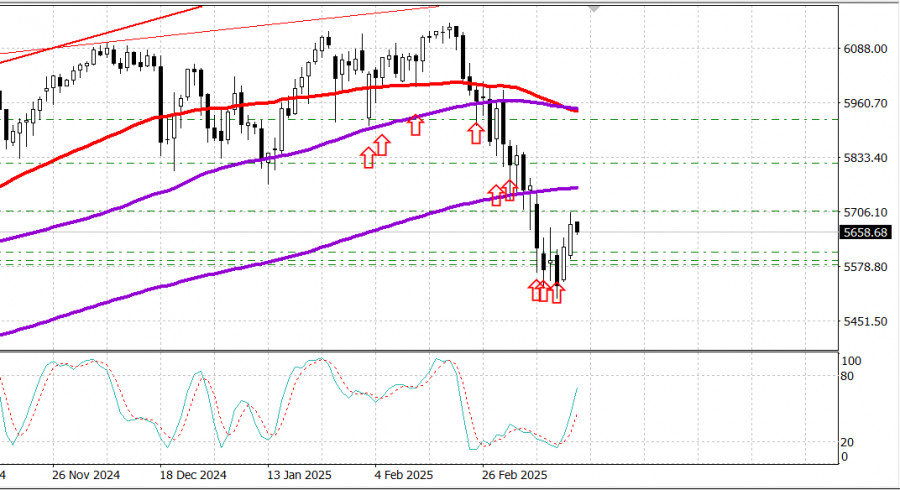

S&P500
US stock market: two days of gains from support levels
Snapshot of major US indices on Monday:
Dow Jones: +0.9% NASDAQ: +0.3% S&P 500: +0.6% (closed at 5,675; range: 5,500 – 6,000)Monday's trading session maintained a positive bias throughout the day. Investors stuck to the "buy-the-dip" strategy after the S&P 500 entered correction territory last week.
Losses in mega-cap stocks initially weighed on the index's performance, but broader market participation signaled stronger buying interest beneath the surface.
Advancers outpaced decliners by 4 to 1 on the NYSE. On Nasdaq, the ratio was 5 to 2. Buying activity accelerated across multiple sectors throughout the session, pushing the major indices to session highs. This followed a Bloomberg report suggesting that newly appointed US Trade Representative Greer aims for a more structured approach to the implementation of reciprocal tariffs on April 2.
The market rebound was also supported by recoveries in key mega-cap stocks:
Apple (AAPL 214.00, +0.51, +0.2%) recovered after falling 1.6% intraday. Microsoft (MSFT 388.70, +0.14, +0.04%) bounced back after dropping 0.8% to its session low.These two stocks account for 13% of the S&P 500's total market capitalization.
Wall Street is alert to pending economic data. Investors closely monitored economic data released in the morning, including:
Retail sales for February, which came in weaker than expected. The New York Fed's March Manufacturing Survey indicated a decline in business activity, along with rising input and output prices.Retail control group sales (excluding autos, gasoline, building materials, and food services) rose 1.0%, showing resilience in core spending.
Sector performance: 10 of 11 S&P 500 sectors finished higher
Energy (+1.7%) led the gains, supported by higher oil prices (WTI crude: $67.58 per barrel, +0.39, +0.6%)
Oil prices climbed on renewed geopolitical tensions in the Middle East after President Trump warned Iran that further Houthi rebel attacks on US ships would be seen as Iran-backed aggression.
Middle East instability continues to drive oil price gains amid supply concerns.
Treasury Yields and Fixed Income Markets
Treasury yields fluctuated as stock buying intensified.
The 10-year U.S. Treasury yield ended the session unchanged at 4.31%. The 2-year Treasury yield rose three basis points to 4.05%.Year-to-date performance of major indices:
Dow Jones: -1.7% S&P 500: -3.5% S&P Midcap 400: -4.8% Nasdaq Composite: -7.8% Russell 2000: -7.3% February Retail Sales Report:Economic calendar on March 17
Retail sales: +0.2% month-over-month (consensus: +0.7%)
January retail sales revised lower to -1.2% (previously -0.9%)
Excluding autos, retail sales: +0.3% (consensus: +0.4%)
Retail control group sales: +1.0% (strong recovery after -1.0% decline in January)
Takeaway: The strong rebound in core retail sales eased concerns about a potential GDP contraction in Q1.
New York Fed's March Manufacturing Survey: General Business Conditions Index: Dropped to -20.0 (from 5.7 in February) Prices Paid Index: Rose five points to 44.9 (highest in over two years)Prices Received Index: Increased three points to 22.4 (highest since May 2023) Business Inventories (January): +0.3% MoM (in line with expectations), December: -0.2% MoM NAHB Housing Market Index (March): dropped to 39 (consensus: 43, previous: 42)Key Insight: The survey reinforced concerns about stagflation risks entering the market.
Economic calendar on March 18
8:30 AM ET:
Housing starts (February) (consensus: 1.385M, previous: 1.366M) Building permits (consensus: 1.450M, previous: 1.483M) Import prices (February) (previous: +0.3%) Export prices (previous: +1.3%) Industrial production (February) (consensus: +0.2%, previous: +0.5%) Capacity utilization (consensus: 77.7%, previous: 77.8%)Ex-oil import prices (previous: +0.1%)
Ex-agriculture export prices (previous: +1.5%)
9:15 AM ET:
Energy markets:
Brent crude: $71.40 per barrel (failed to follow WTI higher)
Oil remains under pressure amid U.S. economic slowdown fears and weaker demand outlook
Final takeaway:
The US stock market confirmed strong support levels, reinforcing a buy-the-dip strategy. It makes sense to hold long positions from key support levels remains justified. If a notable pullback occurs today or tomorrow on the daily S&P 500 chart, adding to positions could be a reasonable strategy—provided capital is available.